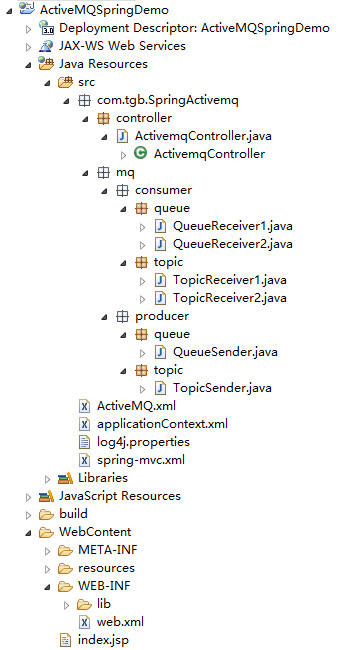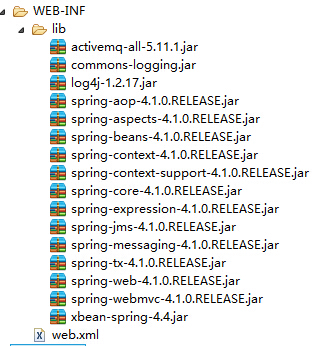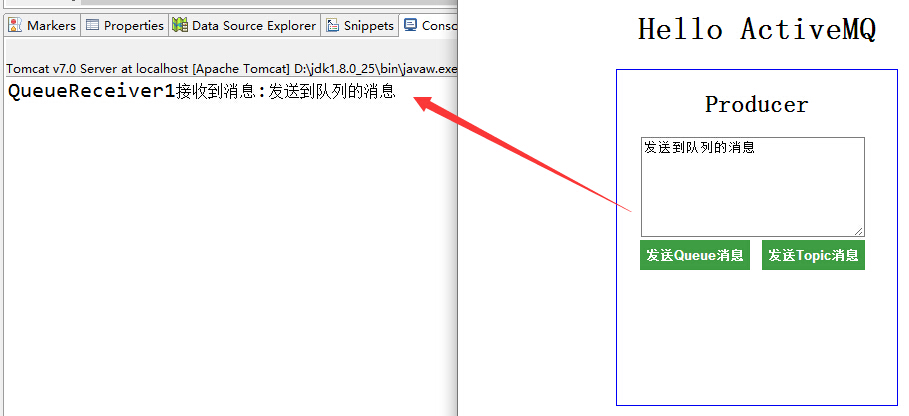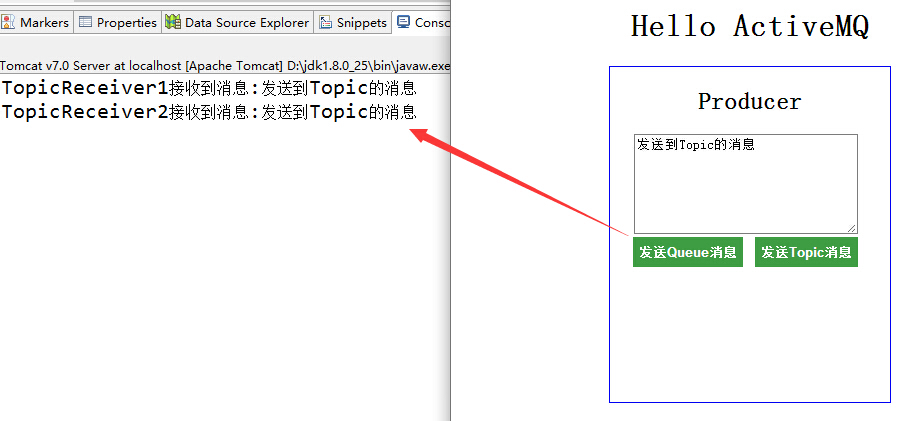深入淺出ActiveMQ(四)--Spring和ActiveMQ整合的完整例項
第一篇博文深入淺出ActiveMQ(一)–JMS基本概念,我們介紹了JMS的兩種訊息模型:點對點和釋出訂閱模型,以及訊息被消費的兩個方式:同步和非同步,JMS程式設計模型的物件,最後說了JMS的優點。
前言
這篇博文,我們基於Spring+JMS+ActiveMQ+Tomcat,做一個Spring4.1.0和ActiveMQ5.11.1整合例項,實現了Point-To-Point的非同步佇列訊息和PUB/SUB(釋出/訂閱)模型,簡單例項,不包含任何業務。
環境準備
工具
-
JDK1.6或1.7
-
Spring4.1.0
-
ActiveMQ5.11.1
-
Tomcat7.x
目錄結構
所需jar包
專案的配置
配置ConnectionFactory
connectionFactory是Spring用於建立到JMS伺服器連結的,Spring提供了多種connectionFactory,我們介紹兩個SingleConnectionFactory和CachingConnectionFactory。
SingleConnectionFactory:對於建立JMS伺服器連結的請求會一直返回同一個連結,並且會忽略Connection的close方法呼叫。
CachingConnectionFactory:繼承了SingleConnectionFactory,所以它擁有SingleConnectionFactory的所有功能,同時它還新增了快取功能,它可以快取Session、MessageProducer和MessageConsumer。我們使用CachingConnectionFactory來作為示例。
<bean id="connectionFactory" class="org.springframework.jms.connection.CachingConnectionFactory">
</bean>- 1
- 2
Spring提供的ConnectionFactory只是Spring用於管理ConnectionFactory的,真正產生到JMS伺服器連結的ConnectionFactory還得是由JMS服務廠商提供,並且需要把它注入到Spring提供的ConnectionFactory中。我們這裡使用的是ActiveMQ實現的JMS,所以在我們這裡真正的可以產生Connection的就應該是由ActiveMQ提供的ConnectionFactory。所以定義一個ConnectionFactory的完整程式碼應該如下所示:
<!-- ActiveMQ 連線工廠 -->
<!-- 真正可以產生Connection的ConnectionFactory,由對應的 JMS服務廠商提供-->
<!-- 如果連線網路:tcp://ip:61616;未連線網路:tcp://localhost:61616 以及使用者名稱,密碼-->
<amq:connectionFactory id="amqConnectionFactory"
brokerURL="tcp://192.168.3.3:61616" userName="admin" password="admin" />
<!-- Spring Caching連線工廠 -->
<!-- Spring用於管理真正的ConnectionFactory的ConnectionFactory -->
<bean id="connectionFactory" class="org.springframework.jms.connection.CachingConnectionFactory">
<!-- 目標ConnectionFactory對應真實的可以產生JMS Connection的ConnectionFactory -->
<property name="targetConnectionFactory" ref="amqConnectionFactory"></property>
<!-- 同上,同理 -->
<!-- <constructor-arg ref="amqConnectionFactory" /> -->
<!-- Session快取數量 -->
<property name="sessionCacheSize" value="100" />
</bean>- 1
- 2
- 3
- 4
- 5
- 6
- 7
- 8
- 9
- 10
- 11
- 12
- 13
- 14
- 15
- 16
配置生產者
配置好ConnectionFactory之後我們就需要配置生產者。生產者負責產生訊息併發送到JMS伺服器。但是我們要怎麼進行訊息傳送呢?通常是利用Spring為我們提供的JmsTemplate類來實現的,所以配置生產者其實最核心的就是配置訊息傳送的JmsTemplate。對於訊息傳送者而言,它在傳送訊息的時候要知道自己該往哪裡發,為此,我們在定義JmsTemplate的時候需要注入一個Spring提供的ConnectionFactory物件。
在利用JmsTemplate進行訊息傳送的時候,我們需要知道傳送哪種訊息型別:一個是點對點的ActiveMQQueue,另一個就是支援訂閱/釋出模式的ActiveMQTopic。如下所示:
<!-- Spring JmsTemplate 的訊息生產者 start-->
<!-- 定義JmsTemplate的Queue型別 -->
<bean id="jmsQueueTemplate" class="org.springframework.jms.core.JmsTemplate">
<!-- 這個connectionFactory對應的是我們定義的Spring提供的那個ConnectionFactory物件 -->
<constructor-arg ref="connectionFactory" />
<!-- 非pub/sub模型(釋出/訂閱),即佇列模式 -->
<property name="pubSubDomain" value="false" />
</bean>
<!-- 定義JmsTemplate的Topic型別 -->
<bean id="jmsTopicTemplate" class="org.springframework.jms.core.JmsTemplate">
<!-- 這個connectionFactory對應的是我們定義的Spring提供的那個ConnectionFactory物件 -->
<constructor-arg ref="connectionFactory" />
<!-- pub/sub模型(釋出/訂閱) -->
<property name="pubSubDomain" value="true" />
</bean>
<!--Spring JmsTemplate 的訊息生產者 end-->- 1
- 2
- 3
- 4
- 5
- 6
- 7
- 8
- 9
- 10
- 11
- 12
- 13
- 14
- 15
- 16
- 17
- 18
- 19
生產者如何指定目的地和傳送訊息?大家看原始碼即可,就不再這提供了。
配置消費者
生產者往指定目的地Destination傳送訊息後,接下來就是消費者對指定目的地的訊息進行消費了。那麼消費者是如何知道有生產者傳送訊息到指定目的地Destination了呢?每個消費者對應每個目的地都需要有對應的MessageListenerContainer。對於訊息監聽容器而言,除了要知道監聽哪個目的地之外,還需要知道到哪裡去監聽,也就是說它還需要知道去監聽哪個JMS伺服器,通過配置MessageListenerContainer的時候往裡面注入一個ConnectionFactory來實現的。所以我們在配置一個MessageListenerContainer的時候有三個屬性必須指定:一個是表示從哪裡監聽的ConnectionFactory;一個是表示監聽什麼的Destination;一個是接收到訊息以後進行訊息處理的MessageListener。
<!-- 訊息消費者 start-->
<!-- 定義Queue監聽器 -->
<jms:listener-container destination-type="queue" container-type="default" connection-factory="connectionFactory" acknowledge="auto">
<jms:listener destination="test.queue" ref="queueReceiver1"/>
<jms:listener destination="test.queue" ref="queueReceiver2"/>
</jms:listener-container>
<!-- 定義Topic監聽器 -->
<jms:listener-container destination-type="topic" container-type="default" connection-factory="connectionFactory" acknowledge="auto">
<jms:listener destination="test.topic" ref="topicReceiver1"/>
<jms:listener destination="test.topic" ref="topicReceiver2"/>
</jms:listener-container>
<!-- 訊息消費者 end -->- 1
- 2
- 3
- 4
- 5
- 6
- 7
- 8
- 9
- 10
- 11
- 12
- 13
- 14
- 15
ActiveMQ.xml
此時,Spring和JMS,ActiveMQ整合的ActiveMQ.xml已經完成,下面展示所有的xml
<?xml version="1.0" encoding="UTF-8"?>
<beans xmlns="http://www.springframework.org/schema/beans"
xmlns:context="http://www.springframework.org/schema/context"
xmlns:xsi="http://www.w3.org/2001/XMLSchema-instance" xmlns:amq="http://activemq.apache.org/schema/core"
xmlns:jms="http://www.springframework.org/schema/jms"
xsi:schemaLocation="http://www.springframework.org/schema/beans
http://www.springframework.org/schema/beans/spring-beans-4.0.xsd
http://www.springframework.org/schema/context
http://www.springframework.org/schema/context/spring-context-4.0.xsd
http://www.springframework.org/schema/jms
http://www.springframework.org/schema/jms/spring-jms-4.0.xsd
http://activemq.apache.org/schema/core
http://activemq.apache.org/schema/core/activemq-core-5.8.0.xsd">
<!-- ActiveMQ 連線工廠 -->
<!-- 真正可以產生Connection的ConnectionFactory,由對應的 JMS服務廠商提供-->
<!-- 如果連線網路:tcp://ip:61616;未連線網路:tcp://localhost:61616 以及使用者名稱,密碼-->
<amq:connectionFactory id="amqConnectionFactory"
brokerURL="tcp://192.168.3.3:61616" userName="admin" password="admin" />
<!-- Spring Caching連線工廠 -->
<!-- Spring用於管理真正的ConnectionFactory的ConnectionFactory -->
<bean id="connectionFactory" class="org.springframework.jms.connection.CachingConnectionFactory">
<!-- 目標ConnectionFactory對應真實的可以產生JMS Connection的ConnectionFactory -->
<property name="targetConnectionFactory" ref="amqConnectionFactory"></property>
<!-- 同上,同理 -->
<!-- <constructor-arg ref="amqConnectionFactory" /> -->
<!-- Session快取數量 -->
<property name="sessionCacheSize" value="100" />
</bean>
<!-- Spring JmsTemplate 的訊息生產者 start-->
<!-- 定義JmsTemplate的Queue型別 -->
<bean id="jmsQueueTemplate" class="org.springframework.jms.core.JmsTemplate">
<!-- 這個connectionFactory對應的是我們定義的Spring提供的那個ConnectionFactory物件 -->
<constructor-arg ref="connectionFactory" />
<!-- 非pub/sub模型(釋出/訂閱),即佇列模式 -->
<property name="pubSubDomain" value="false" />
</bean>
<!-- 定義JmsTemplate的Topic型別 -->
<bean id="jmsTopicTemplate" class="org.springframework.jms.core.JmsTemplate">
<!-- 這個connectionFactory對應的是我們定義的Spring提供的那個ConnectionFactory物件 -->
<constructor-arg ref="connectionFactory" />
<!-- pub/sub模型(釋出/訂閱) -->
<property name="pubSubDomain" value="true" />
</bean>
<!--Spring JmsTemplate 的訊息生產者 end-->
<!-- 訊息消費者 start-->
<!-- 定義Queue監聽器 -->
<jms:listener-container destination-type="queue" container-type="default" connection-factory="connectionFactory" acknowledge="auto">
<jms:listener destination="test.queue" ref="queueReceiver1"/>
<jms:listener destination="test.queue" ref="queueReceiver2"/>
</jms:listener-container>
<!-- 定義Topic監聽器 -->
<jms:listener-container destination-type="topic" container-type="default" connection-factory="connectionFactory" acknowledge="auto">
<jms:listener destination="test.topic" ref="topicReceiver1"/>
<jms:listener destination="test.topic" ref="topicReceiver2"/>
</jms:listener-container>
<!-- 訊息消費者 end -->
</beans> - 1
- 2
- 3
- 4
- 5
- 6
- 7
- 8
- 9
- 10
- 11
- 12
- 13
- 14
- 15
- 16
- 17
- 18
- 19
- 20
- 21
- 22
- 23
- 24
- 25
- 26
- 27
- 28
- 29
- 30
- 31
- 32
- 33
- 34
- 35
- 36
- 37
- 38
- 39
- 40
- 41
- 42
- 43
- 44
- 45
- 46
- 47
- 48
- 49
- 50
- 51
- 52
- 53
- 54
- 55
- 56
- 57
- 58
- 59
- 60
- 61
- 62
- 63
- 64
- 65
- 66
- 67
- 68
鑑於博文內容較多,我們只是在貼上web.xml的配置,就不在博文中提供Spring和SpringMVC的XML配置,其他內容,大家檢視原始碼即可。
web.xml
<?xml version="1.0" encoding="UTF-8"?>
<web-app xmlns:xsi="http://www.w3.org/2001/XMLSchema-instance"
xmlns="http://java.sun.com/xml/ns/javaee" xmlns:web="http://java.sun.com/xml/ns/javaee/web-app_3_0.xsd"
xsi:schemaLocation="http://java.sun.com/xml/ns/javaee http://java.sun.com/xml/ns/javaee/web-app_3_0.xsd"
version="3.0">
<display-name>ActiveMQSpringDemo</display-name>
<!-- Log4J Start -->
<context-param>
<param-name>log4jConfigLocation</param-name>
<param-value>classpath:log4j.properties</param-value>
</context-param>
<context-param>
<param-name>log4jRefreshInterval</param-name>
<param-value>6000</param-value>
</context-param>
<!-- Spring Log4J config -->
<listener>
<listener-class>org.springframework.web.util.Log4jConfigListener</listener-class>
</listener>
<!-- Log4J End -->
<!-- Spring 編碼過濾器 start -->
<filter>
<filter-name>characterEncoding</filter-name>
<filter-class>org.springframework.web.filter.CharacterEncodingFilter</filter-class>
<init-param>
<param-name>encoding</param-name>
<param-value>UTF-8</param-value>
</init-param>
<init-param>
<param-name>forceEncoding</param-name>
<param-value>true</param-value>
</init-param>
</filter>
<filter-mapping>
<filter-name>characterEncoding</filter-name>
<url-pattern>/*</url-pattern>
</filter-mapping>
<!-- Spring 編碼過濾器 End -->
<!-- Spring Application Context Listener Start -->
<context-param>
<param-name>contextConfigLocation</param-name>
<param-value>classpath*:applicationContext.xml,classpath*:ActiveMQ.xml</param-value>
</context-param>
<listener>
<listener-class>org.springframework.web.context.ContextLoaderListener</listener-class>
</listener>
<!-- Spring Application Context Listener End -->
<!-- Spring MVC Config Start -->
<servlet>
<servlet-name>SpringMVC</servlet-name>
<servlet-class>org.springframework.web.servlet.DispatcherServlet</servlet-class>
<init-param>
<param-name>contextConfigLocation</param-name>
<param-value>classpath:spring-mvc.xml</param-value>
</init-param>
<load-on-startup>1</load-on-startup>
</servlet>
<servlet-mapping>
<servlet-name>SpringMVC</servlet-name>
<!-- Filter all resources -->
<url-pattern>/</url-pattern>
</servlet-mapping>
<!-- Spring MVC Config End -->
</web-app>- 1
- 2
- 3
- 4
- 5
- 6
- 7
- 8
- 9
- 10
- 11
- 12
- 13
- 14
- 15
- 16
- 17
- 18
- 19
- 20
- 21
- 22
- 23
- 24
- 25
- 26
- 27
- 28
- 29
- 30
- 31
- 32
- 33
- 34
- 35
- 36
- 37
- 38
- 39
- 40
- 41
- 42
- 43
- 44
- 45
- 46
- 47
- 48
- 49
- 50
- 51
- 52
- 53
- 54
- 55
- 56
- 57
- 58
- 59
- 60
- 61
- 62
- 63
- 64
- 65
- 66
- 67
- 68
- 69
- 70
- 71
執行效果
從上圖可以看出佇列模型和PUB/SUB模型的區別,Queue只能由一個消費者接收,其他Queue中的成員無法接受到被已消費的資訊,而Topic則可以,只要是訂閱了Topic的消費者,全部可以獲取到生產者釋出的資訊。
總結
Spring提供了對JMS的支援,ActiveMQ提供了很好的實現,而此時我們已經將兩者完美的結合在了一起。




